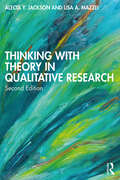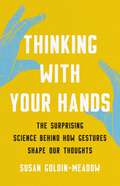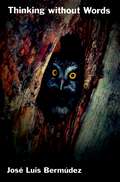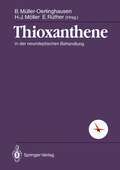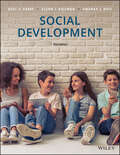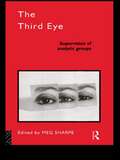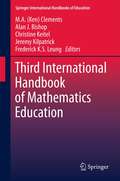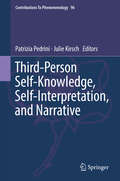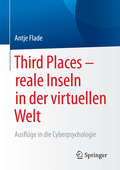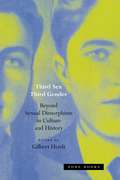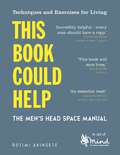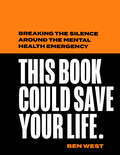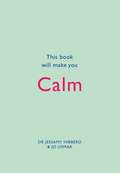- Table View
- List View
Thinking with Theory in Qualitative Research
by Alecia Y. Jackson Lisa A. MazzeiThinking with Theory in Qualitative Research: Second Edition demonstrates how to enact various philosophical concepts in practices of inquiry, effectively opening up the process of thought in qualitative studies. Thinking with Theory in Qualitative Research functions as a refusal of pregiven method, intensifying creativity, experimentation, and newness. Readers are invited into the threshold of theory to traverse philosophers and their concepts, reorienting conventional approaches to inquiry. Each chapter presents a thinking with process as a way of reading intensively through plugging in performative accounts of two first-generation academic women to philosophical concepts from Derrida, Spivak, Foucault, Butler, Barad, and Deleuze and Guattari. This book is a deliberate attempt to unsettle what is expected to be represented or recognized in terms of both meaning and method in traditional practices of qualitative research, which become unproductive and untenable in this different image of thought. New to this edition Fully revised and rewritten Chapter 1 that introduces the technique of plugging in as contingent, strategic movements of thought. Also new to Chapter 1 is a shift in language away from traditional practices in qualitative research (data and analysis) to performative accounts and becoming-questions Fully revised "Thinking with intra-action" chapter, which focuses on Karen Barad’s ontoepistemological framework of agential realism, and the concepts of posthumanist performativity and entangled agencies Fully revised and rewritten Chapter 8 that presents plugging in and thinking with as ontological Further development of and new material on the "plugging in" technique Schematic cues updated and extended for all of the Interludes In the ten years since the first edition was published, Thinking with Theory in Qualitative Research has become a vanguard text in the field of postfoundational inquiry for its accessible but thorough introductions to philosophically informed inquiry. This book is for experienced and novice researchers, and students in introductory, general, and advanced qualitative inquiry courses, who may also be first-time readers of philosophy. This text will function as an entry into techniques of thinking with a new theoretical vocabulary.
Thinking with Your Hands: The Surprising Science Behind How Gestures Shape Our Thoughts
by Susan Goldin-MeadowAn astounding account of how gesture, long overlooked, is essential to how we learn and interact, which &“changes the way you think about yourself and the people around you.&” (Ethan Kross, bestselling author of Chatter) We all know people who talk with their hands—but do they know what they&’re saying with them? Our gestures can reveal and contradict us, and express thoughts we may not even know we&’re thinking. In Thinking with Your Hands, esteemed cognitive psychologist Susan Goldin-Meadow argues that gesture is vital to how we think, learn, and communicate. She shows us, for instance, how the height of our gestures can reveal unconscious bias, or how the shape of a student&’s gestures can track their mastery of a new concept—even when they&’re still giving wrong answers. She compels us to rethink everything from how we set child development milestones, to what&’s admissible in a court of law, to whether Zoom is an adequate substitute for in-person conversation. Sweeping and ambitious, Thinking with Your Hands promises to transform the way we think about language and communication.
Thinking Without Words (Philosophy of Mind)
by Jose Luis BermudezThinking without Words provides a challenging new theory of the nature of non-linguistic thought. Many scientific disciplines treat non-linguistic creatures as thinkers, explaining their behavior in terms of their thoughts about themselves and about the environment. But this theorizing has proceeded without any clear account of the types of thinking available to non-linguistic creatures. One consequence of this is that ascriptions of thoughts to non-linguistic creatures have frequently been held to be metaphorical and not to be taken at face value. Bermúdez offers a conceptual framework for treating human infants and non-human animals as genuine thinkers. Whereas existing discussions of thought at the non-linguistic level have concentrated on how such thoughts might be physically realized, Bermúdez approaches the problem by considering what is required in explaining behavior in psychological terms. In developing a positive account of non-linguistic thought he shows how the experimental tools used by developmental psychologists and students of animal behavior can be used to give a precise account of the way in which a human infant or non-human animal is representing the world. Much of the book is devoted to exploring the differences between thinking without words and language-based thinking. Bermúdez argues that there are clear limits to the expressive power of non-linguistic thought. Nonetheless, he identifies primitive analogues at the non-linguistic level that can be used to explain sophisticated non-linguistic behaviors. Thinking Without Words is the first full-length philosophical study of this important topic. It is written with an interdisciplinary readership in mind and will appeal to philosophers, psychologists, and students of animal behavior.
Thioxanthene: in der neuroleptischen Behandlung
by B. Müller-Oerlinghausen H. J. Möller E. RütherDas Buch beschäftigt sich mit aktuellen Problemen der Neuroleptika-Behandlung. Dabei wird insbesondere auf den Stellenwert der Thioxanthene eingegangen.
The Third Eye: Supervision of Analytic Groups (The International Library of Group Psychotherapy and Group Process)
by Meg SharpeThe Third Eye provides a detailed and practical exposition of one of the most important but least documented skills required of those practising in the expanding discipline of group analysis. The relevance of the material, which is contributed from the dual perspective of both experienced practitioner and inexperienced trainee, extends far beyond its field of origin. It will be of significant interest to a wide readership of all those concerned with the training assessment and development of others working with groups.
The Third Eye: Supervision of Analytic Groups (The International Library of Group Psychotherapy and Group Process)
by Meg SharpeThe Third Eye provides a detailed and practical exposition of one of the most important but least documented skills required of those practising in the expanding discipline of group analysis. The relevance of the material, which is contributed from the dual perspective of both experienced practitioner and inexperienced trainee, extends far beyond its field of origin. It will be of significant interest to a wide readership of all those concerned with the training assessment and development of others working with groups.
Third International Handbook of Mathematics Education (Springer International Handbooks of Education #27)
by Christine Keitel, Jeremy Kilpatrick And Frederic Alan J. Bishop, Christine Keitel BishopThe four sections in this Third International Handbook are concerned with: (a) social, political and cultural dimensions in mathematics education; (b) mathematics education as a field of study; (c) technology in the mathematics curriculum; and (d) international perspectives on mathematics education. These themes are taken up by 84 internationally-recognized scholars, based in 26 different nations. Each of section is structured on the basis of past, present and future aspects. The first chapter in a section provides historical perspectives (“How did we get to where we are now?”); the middle chapters in a section analyze present-day key issues and themes (“Where are we now, and what recent events have been especially significant?”); and the final chapter in a section reflects on policy matters (“Where are we going, and what should we do?”). Readership: Teachers, mathematics educators, ed.policy makers, mathematicians, graduate students, undergraduate students. Large set of authoritative, international authors.
Third-Person Self-Knowledge, Self-Interpretation, and Narrative (Contributions To Phenomenology #96)
by Patrizia Pedrini Julie KirschThis volume answers questions that lead to a clearer picture of third-person self- knowledge, the self-interpretation it embeds, and its narrative structure. Bringing together current research on third-person self-knowledge and self-interpretation, the book focuses on third-person self-knowledge, and the role that narrative and interpretation play in acquiring it. It regards the third-personal epistemic approach to oneself as a problem worthy of investigation in its own right, and makes clear the relation between third-person self-knowledge, self-interpretation, and narrative capacities. In recent years, the idea that each person is in a privileged position to acquire knowledge about her own mental states has come under attack. A growing body of empirical research has cast doubt upon the existence of what philosophers call ‘first person self-knowledge’, i.e., knowledge about our mental states that is often thought to be immediate, transparent, and authoritative. This line of thought has led some philosophers to claim that what seems to be ‘first-person self-knowledge’ is really just ‘third-person self-knowledge,’ i.e., knowledge about our mental states that is inferential, opaque, and fallible. This book discusses challenges for first-person knowledge and explores the true nature of third-person knowledge.
Third Places – reale Inseln in der virtuellen Welt: Ausflüge in die Cyberpsychologie
by Antje FladeMit der Erfindung und Verbreitung des Computers und Internets hat sich eine neuartige Umwelt aufgetan, die als virtuelle Welt zunehmend zu einem Einflussfaktor wird, der neben der realen Umwelt den Menschen prägt und seine Lebensweise bestimmt. In dem Buch werden zwei Fragestellungen untersucht:Wie verändert die Digitalisierung der Gesellschaft den Menschen?Verliert die reale Umwelt für den Menschen als Erlebens- und Handlungsraum an Bedeutung?Wichtige Themen sind Informationsselektion, Kommunikationsformen, Privatheit und Autonomie.
Third Sex, Third Gender: Beyond Sexual Dimorphism in Culture and History
by Gilbert HerdtMost modern discussions of the relationship of biological sex to gender presuppose that there are two genders, male and female, founded on the two biological sexes. But not all cultures share this essentialist assumption, and even Western societies have not always embraced it. Bringing together historical and anthropological studies, Third Sex, Third Gender challenges the usual emphasis on sexual dimorphism and reproduction, providing a unique perspective on the various forms of socialization of people who are neither “male” nor “female.”The existence of a third sex or gender enables us to understand how Byzantine palace eunuchs and Indian hijras met the criteria of special social roles that necessitated practices such as self-castration, and how intimate and forbidden desires were expressed among the Dutch Sodomites in the early modern period, the Sapphists of eighteenth-century England, or the so-called hermaphrodite-homosexuals of nineteenth-century Europe and America. By contextualizing these practices and by allowing these bodies, meanings, and desires to emerge, Third Sex, Third Gender provides a new way to think about sex and gender systems that is crucial to contemporary debates within the social sciences.
Third Sex, Third Gender: Beyond Sexual Dimorphism in Culture and History
by Gilbert HerdtMost modern discussions of the relationship of biological sex to gender presuppose that there are two genders, male and female, founded on the two biological sexes. But not all cultures share this essentialist assumption, and even Western societies have not always embraced it. Bringing together historical and anthropological studies, Third Sex, Third Gender challenges the usual emphasis on sexual dimorphism and reproduction, providing a unique perspective on the various forms of socialization of people who are neither “male” nor “female.”The existence of a third sex or gender enables us to understand how Byzantine palace eunuchs and Indian hijras met the criteria of special social roles that necessitated practices such as self-castration, and how intimate and forbidden desires were expressed among the Dutch Sodomites in the early modern period, the Sapphists of eighteenth-century England, or the so-called hermaphrodite-homosexuals of nineteenth-century Europe and America. By contextualizing these practices and by allowing these bodies, meanings, and desires to emerge, Third Sex, Third Gender provides a new way to think about sex and gender systems that is crucial to contemporary debates within the social sciences.
Third Wave CBT Integration for Individuals and Teams: Comprehend, Cope and Connect
by Isabel Clarke Hazel NichollsThird Wave CBT Integration for Individuals and Teams: Comprehend, Cope and Connect introduces a therapy that starts from the perspective of the immediate experience of the individual. Developed by the authors, this new, transdiagnostic approach to mental health difficulties brings together the impact of past trauma and adversity on present coping (comprehend), and utilizes the latest in mindfulness and compassion-focused approaches to manage change (cope and connect).Already adopted in a variety of settings, the book demonstrates the approach’s practicality and adaptability of the therapy. The text explores the cognitive science-based theory behind the approach and its place within the range of ‘third wave’. It also includes a full manual of the linked individual and group therapy approach piloted in primary care IAPT, including case examples. The application of the approach to psychosis, its adoption in a variety of settings and the evidence base to date are also discussed. Third Wave CBT Integration for Individuals and Teams will be warmly welcomed by IAPT practicitioners looking to adopt a new, third wave CBT approach, as well as other CBT practitioners and clinical psychologists.
Third Wave CBT Integration for Individuals and Teams: Comprehend, Cope and Connect
by Isabel Clarke Hazel NichollsThird Wave CBT Integration for Individuals and Teams: Comprehend, Cope and Connect introduces a therapy that starts from the perspective of the immediate experience of the individual. Developed by the authors, this new, transdiagnostic approach to mental health difficulties brings together the impact of past trauma and adversity on present coping (comprehend), and utilizes the latest in mindfulness and compassion-focused approaches to manage change (cope and connect).Already adopted in a variety of settings, the book demonstrates the approach’s practicality and adaptability of the therapy. The text explores the cognitive science-based theory behind the approach and its place within the range of ‘third wave’. It also includes a full manual of the linked individual and group therapy approach piloted in primary care IAPT, including case examples. The application of the approach to psychosis, its adoption in a variety of settings and the evidence base to date are also discussed. Third Wave CBT Integration for Individuals and Teams will be warmly welcomed by IAPT practicitioners looking to adopt a new, third wave CBT approach, as well as other CBT practitioners and clinical psychologists.
Third-Wave Cognitive Therapy for the Treatment of Loss and Grief: A Clinician's Guide
by Faramarz Hashempour Navya AnandThis book proposes and explores a novel conceptualisation of the grieving process grounded in evolutionary psychology that integrates cognitive behavioural approaches such as compassion focused therapy, metacognitive awareness, and acceptance and commitment therapy. Starting with an introduction of the historical and theoretical basis for the Principles of Loss model, the book then outlines methods of assessment and describes the processes of formulation and case conceptualisation, with specific guidance on how to navigate these in the context of loss. The book provides an in-depth exploration of the Five-Phase Principles for the Treatment of Loss and Grief (intervention), as well as guidance on the supervision of loss. The chapters, accompanied by case studies, provide an overview of the novel model, followed by specific and tailor-made guidance on assessment (including a novel self-report measure), formulation, treatment, and supervision. This guide is intended for clinicians familiar with or interested in the theory and practice of third-wave cognitive behavioural therapies.
Third-Wave Cognitive Therapy for the Treatment of Loss and Grief: A Clinician's Guide
by Faramarz Hashempour Navya AnandThis book proposes and explores a novel conceptualisation of the grieving process grounded in evolutionary psychology that integrates cognitive behavioural approaches such as compassion focused therapy, metacognitive awareness, and acceptance and commitment therapy. Starting with an introduction of the historical and theoretical basis for the Principles of Loss model, the book then outlines methods of assessment and describes the processes of formulation and case conceptualisation, with specific guidance on how to navigate these in the context of loss. The book provides an in-depth exploration of the Five-Phase Principles for the Treatment of Loss and Grief (intervention), as well as guidance on the supervision of loss. The chapters, accompanied by case studies, provide an overview of the novel model, followed by specific and tailor-made guidance on assessment (including a novel self-report measure), formulation, treatment, and supervision. This guide is intended for clinicians familiar with or interested in the theory and practice of third-wave cognitive behavioural therapies.
Thirteen Ways of Looking at a Man: Psychoanalysis and Masculinity
by Donald MossImages and ideas associated with masculinity are forever in flux. In this book, Donald Moss addresses the never-ending effort of men—regardless of sexual orientation—to shape themselves in relation to the unstable notion of masculinity. Part 1 looks at the lifelong labor faced by boys and men of assessing themselves in relation to an always shifting, always receding, ideal of "masculinity." In Part 2, Moss considers a series of nested issues regarding homosexuality, homophobia and psychoanalysis. Part 3 focuses on the interface between the body experienced as a private entity and the body experienced as a public entity—the body experienced as one’s own and the body subject to the judgments, regulations and punishments of the external world. The final part looks at men and violence. Men must contend with the entwined problems of regulating aggression and figuring out its proper level, aiming to avoid both excess and insufficiency. This section focuses on excessive aggression and its damaging consequences, both to its object and to its subjects. Thirteen Ways Of Looking At A Man will be of great interest not only to psychoanalysts and psychotherapists, but also to a much wider audience of readers interested in gender studies, queer studies, and masculinity.
Thirteen Ways of Looking at a Man: Psychoanalysis and Masculinity
by Donald MossImages and ideas associated with masculinity are forever in flux. In this book, Donald Moss addresses the never-ending effort of men—regardless of sexual orientation—to shape themselves in relation to the unstable notion of masculinity. Part 1 looks at the lifelong labor faced by boys and men of assessing themselves in relation to an always shifting, always receding, ideal of "masculinity." In Part 2, Moss considers a series of nested issues regarding homosexuality, homophobia and psychoanalysis. Part 3 focuses on the interface between the body experienced as a private entity and the body experienced as a public entity—the body experienced as one’s own and the body subject to the judgments, regulations and punishments of the external world. The final part looks at men and violence. Men must contend with the entwined problems of regulating aggression and figuring out its proper level, aiming to avoid both excess and insufficiency. This section focuses on excessive aggression and its damaging consequences, both to its object and to its subjects. Thirteen Ways Of Looking At A Man will be of great interest not only to psychoanalysts and psychotherapists, but also to a much wider audience of readers interested in gender studies, queer studies, and masculinity.
Thirty Years CINP: A Brief History of the Collegium Internationale Neuro-Psychopharmacologicum
by Thomas A. Ban and Hanns HippiusThe development of modern psychopharmacology was triggered by two major discoveries: the psychomimetic effects of lysergic acid diethylamide (LSD-25) in 1943 and the therapeutic effects of chlorpromazine in 1952. In his opening address to the 1st CINP Congress in Rome, Rothlin pointed out that these discoveries gave "a great impetus for any kind of scientific approach to brain research" and had "revolutionary consequences in the treatment of psychotic patients". The incentive they provided "was not limited to theoretical and practical medical sciences but caused an even greater stimulus to the imagination of chemists, leading to the production of new compounds with a speed that neither pharmacological, biochemical nor clinical investigations could equitably follow. " The possibility to induce psychopathology by the administration of pharmacological agents and to control naturally occurring psychopathol ogy by drugs opened unforeseen possibilities for brain research and a new era in psychiatry. In psychiatry, the new psychotropic drugs with their increasingly better defined behavioral, neurophysiological and biochemi cal actions have provided a new means for therapeutically influencing and systematically studying psychopathological conditions, whereas in the basic sciences, neuropharmacological research, directed to reveal the action mechanism of new drugs, brought about unprecedented progress in the identification of the morphological substrate of different brain func tions. It also set the stage for the exploration of possible correlations between behavioral, including psychopathological, and neurochemical events.
This Art of Psychoanalysis: Dreaming Undreamt Dreams and Interrupted Cries (The New Library of Psychoanalysis)
by Thomas H OgdenWinner of the 2010 Haskell Norman Prize for Outstanding Achievement in Psychoanalysis! Why is dreaming the mind's single most important psychoanalytic activity? This Art of Psychoanalysis offers a unique perspective on psychoanalysis that features a new way of conceptualizing the role of dreaming in human psychology. Thomas Ogden's thinking has been at the cutting edge of psychoanalysis for more than 25 years. In this volume, he builds on the work of Freud, Klein, Winnicott, and Bion and explores the idea that human psychopathology is a manifestation of a breakdown of the individual's capacity to dream his experience. The investigation into the role of the analyst in participating psychologically in the patient's dreaming is illustrated throughout with elegant and absorbing accounts of clinical work, providing a fascinating insight into the analyst's experience. Subjects covered include: a new reading of the origins of object relations theory on holding and containing, being and dreaming on psychoanalytic writing. This engaging book succeeds in conveying not just a set of techniques but a way of being with patients that is humane and compassionate. It will be of great interest to psychoanalysts, psychotherapists and other mental health professionals.
This Art of Psychoanalysis: Dreaming Undreamt Dreams and Interrupted Cries (The New Library of Psychoanalysis)
by Thomas H OgdenWinner of the 2010 Haskell Norman Prize for Outstanding Achievement in Psychoanalysis! Why is dreaming the mind's single most important psychoanalytic activity? This Art of Psychoanalysis offers a unique perspective on psychoanalysis that features a new way of conceptualizing the role of dreaming in human psychology. Thomas Ogden's thinking has been at the cutting edge of psychoanalysis for more than 25 years. In this volume, he builds on the work of Freud, Klein, Winnicott, and Bion and explores the idea that human psychopathology is a manifestation of a breakdown of the individual's capacity to dream his experience. The investigation into the role of the analyst in participating psychologically in the patient's dreaming is illustrated throughout with elegant and absorbing accounts of clinical work, providing a fascinating insight into the analyst's experience. Subjects covered include: a new reading of the origins of object relations theory on holding and containing, being and dreaming on psychoanalytic writing. This engaging book succeeds in conveying not just a set of techniques but a way of being with patients that is humane and compassionate. It will be of great interest to psychoanalysts, psychotherapists and other mental health professionals.
This Book Could Help: The Men's Head Space Manual – Techniques and Exercises for Living
by MIND Rotimi Akinsete'Incredibly helpful - every man should have a copy' —Colin Jackson, former olympic athlete'This book will save lives.' —Elis & John, Radio X'An essential read' —Levison Wood, author and explorer___________________Your body needs maintaining to keep it healthy. So does your mind.Sounds simple, but tired and outdated ideas that tell men how they ought to be, mean the message gets lost. And the results speak for themselves: suicide is the biggest killer of men under fifty. There’s no more room for debate – taking care of your head space should be as normal as eating your five-a-day or going to the gym. Many books make impossible promises about how they will fix all your problems and stresses with some miraculous ten-step programme. This one doesn’t. What it does do is provide practical help, when times are tough and also when they’re not. And just like with your physical health, it doesn’t always have to take much to make a difference.Developed in partnership with Mind, the mental health charity, This Book Could Help is filled with straightforward expert advice and simple techniques to help you shake off what other people say you ought to be, prioritize yourself, meet challenges and develop new strengths, in areas such as dealing with stress, motivation, work and life goals. We all deserve to live fully and respect our struggles, so start here and back yourself every day.Because head space is not a luxury, it’s essential.
This Book Could Save Your Life: Breaking The Silence Around The Mental Health Emergency
by Ben WestWhat’s sort of funny when something horrific happens is that nothing happens to the rest of the world. The cars still drive, the planes still fly… everything just continues. And that’s probably the best gift we have. Because, for the most part, there’s no right or wrong way to do things – life becomes whatever you make it.
This Book Will Change Your Mind About Mental Health: A journey into the heartland of psychiatry
by Nathan Filer'I cannot recommend it highly enough.' Caitlin Moran 'Brims with compassion and wit.' Cathy Rentzenbrink 'Absolutely blew me away.' Jo Brand'Brilliant . . . I love it.' Phillippa Perry'I have never read a more powerful book about mental health.' Joanna CannonA journey into the heartland of psychiatry.This book debunks myths, challenges assumptions and offers fresh insight into what it means to be mentally ill. And what it means to be human. This Book Will Change Your Mind About Mental Health was previously published in 2019 under the title The Heartland.
This Book Will Make You Calm (This Book Will... Ser.)
by Jessamy Hibberd Jo UsmarLife in the 21st century is tough - new technology, constant change, more choice and extra pressure all add to our stress levels. And when you're stressed or tired your insecurities increase - so breaking that cycle feels impossible. But help is at hand: this book will show you how to beat stress and become more positive, relaxed and productive. Dr Jessamy Hibberd and Jo Usmar draw on the latest cognitive behavioural therapy (CBT) research to show you how to develop coping strategies and learn practical techniques to deal with stress and anxiety quickly and effectively. From reducing worry and boosting energy to breathing and mindfulness techniques, this helpful little book will make your life more serene, stress-free and fulfilled.
